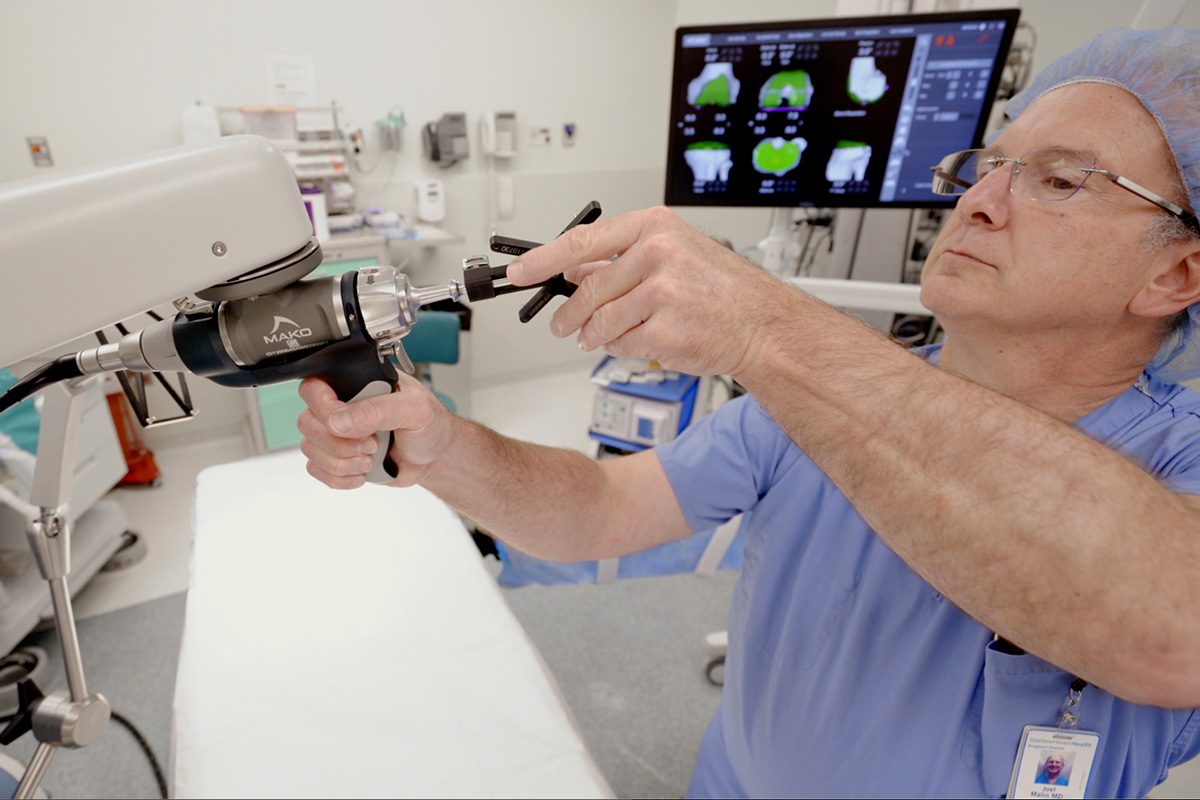
Popular Locations
- Outpatient Surgery - Bridgeport Hospital
- Park Avenue Medical Center
- Primary Care Center - Bridgeport Hospital

Published January 30, 2023

It frequently starts with pain in the hip or groin. Many complain of stiffness when bending over to put on their socks or they find themselves limping while walking. Over time, a diseased or damaged hip joint can lead to ongoing pain that interferes with sleep and daily activities. This is a common scenario for those considering total hip replacement surgery, and orthopedic surgeons at the Bridgeport Hospital Milford Campus stand ready to help.

For Susan Morrison, hip replacement surgery was a logical next step. “Everybody has different kinds of pain and tolerance levels,” she said. “At first, you don’t realize there is anything going on, but then the pain begins to cause you to start thinking about whether you really want to walk in the grocery store or get in and out of the car an extra time. You begin to limit your activities, whatever they are, so unless you just want to sit and knit, you go to the orthopedist.”
That’s what the Fairfield resident did. In October, she underwent her second hip replacement surgery with orthopedic surgeon Joel Malin, MD. Eight years ago, Dr. Malin had replaced her left hip at Bridgeport Hospital; this time, Dr. Malin replaced her damaged right hip joint using a newer robotically assisted technique available at the Bridgeport Hospital Milford Campus.
“We started our robotics journey in Milford in 2019,” said Dr. Malin, who directs the robotics program at the Milford Campus. “We’re pushing about 700 cases now, and that’s both hip and knee replacements. At this point, I am almost exclusively using robotics.”
Dr. Malin said he uses the Stryker Mako® robot in robotic-assisted joint replacement surgeries, often with an anterior approach that allows access to the hip from the front of the patient’s body.
“The Mako is a robotic arm-assisted device that allows us to plan and position implants, particularly with hip and knee replacement,” Dr. Malin explained. “On hips, it allows us to position and space the implant, and check and confirm what we call offset and leg length, so that we can equalize leg length.
“Hip replacement has been around since the early 1970s, and it’s gone through multiple iterations,” Dr. Malin noted. “In its current iteration, the implants haven’t really changed. What has changed is our ability to deliver that implant into the hard tissues – the bone – precisely, within a millimeter of where you would like to place the implant.”
In addition to robotics technology, Bridgeport Hospital Milford Campus offers a range of surgical and nonsurgical therapies for patients suffering from painful or degenerative conditions of the muscles, bones and joints, as well as a full range of joint replacement procedures and orthopedic care tailored to patient needs.
“Our techniques have become more minimally invasive, and the length of stay in the hospital has also changed,” said Amit Lahav, MD, a Northeast Medical Group orthopedic surgeon, medical director of the Total Joint Program and Orthopedics medical director – Quality and Safety, at the Bridgeport Hospital Milford Campus. “It used to be you’d be in the hospital from three to seven days after a total joint replacement. Now, if patients stay, it’s generally just overnight.”
Regional anesthesia has contributed toward those shorter hospital stays, Dr. Lahav explained. Under regional anesthesia, patients may be sedated and can breathe on their own instead of using a breathing tube and ventilator with general anesthesia, which requires additional postoperative recovery time.
In addition to shorter hospital stays, another benefit is less pain. “We also have better pain control and regimens that we did not have 10 years ago,” said Dr. Lahav, who primarily uses a posterior approach to hip replacement, one that allows the surgeon to access the hip from the back.
“Patients are up walking within a couple of hours after surgery and many of these operations are same-day surgeries,” he said. “Most patients are fully back to function by six weeks, plus or minus.”
“Hip replacement is for people suffering from either degenerative arthritis or an inflammatory arthritis – classically, rheumatoid arthritis,” Dr. Malin said. “It’s diagnosed based on physical exam, and it’s confirmed, usually, with X-rays. The very advanced stages show bone-on-bone arthritis, and the less advanced stages will show joint narrowing or subluxation.”
Dr. Lahav tells patients total joint replacement is recommended for three reasons:
“If you are experiencing all three, then we start to discuss surgical intervention, and that’s hip replacement,” he said.
Learn more about joint replacement and orthopedic services at Bridgeport Hospital